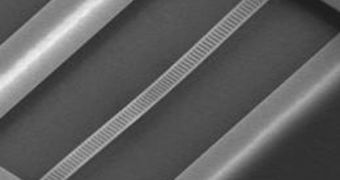Guiding light through optical fibers was never something easy to do, and the communication industry has been using photonic crystals – specially patterned materials – for the job since the early days. In mobile phones, unwanted frequencies are screened out using similar materials, called phononic crystals, which are able to manipulate mechanical vibrations. Now, for the first time, a group of scientists has learned how to combine the two in one, creating a type of crystal that is able to store both light and mechanical vibrations, Nature News reports.
The new “optomechanical” innovation was created at the California Institute of Technology (Caltech), by a team of scientists led by expert Oskar Painter. It can control, trap and guide light and vibrations, a trait that could see it being used for constructing more accurate biosensors, creating interfaces for devices on a chip, and also for creating cooling mechanisms for testing quantum limits.
The two types of crystals that were combined for the innovation perform very different tasks in real life, but Painter says that their structures are remarkably similar to each other. “If you make one type of crystal, you almost automatically make the other type,” he explains. This knowledge, the expert reveals, was not put to use before, simply because vibrations in crystals the size of those used in optics today are very difficult to measure and detect.
The new crystal was obtained from a ten-micrometer-long strip of silicon, on which rectangular patterns were etched out at predefined distances, creating what appeared to look like a very tiny railway. The interactions between incoming light and the “tracks” should ensure that at least a small part of the wavelengths is reflected at each individual rectangle. Eventually, computer simulations have shown, the interactions between forward and reflected light should lock the light in place at the center of the structure.
Mechanical vibrations entering the new crystal at the same time, and with the same wavelength, would make the center rail in the silicon strip oscillate back and forth, becoming trapped in the process as well. “It's not an easy experiment. Intuitively, I wouldn't have expected those [crystals] to shake so strongly that the vibrations could be picked up,” Harvard School of Engineering and Applied Sciences optical physicist Marko Loncar says of the research.

 14 DAY TRIAL //
14 DAY TRIAL //